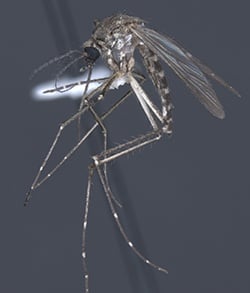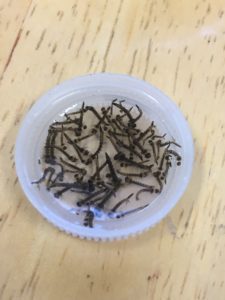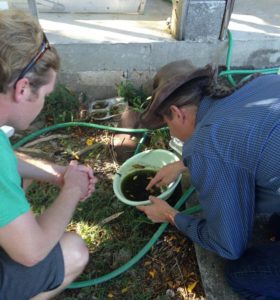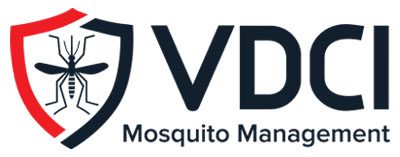Exploring Mosquito Species: Aedes Vexans
Cosmopolitan – a species of the world, present in many countries and absent in only a few. No mosquito fits this description better than the Inland Floodwater Mosquito, Aedes vexans. They have been collected on every continent except Antarctica and South America. In most of North America this is the dominant mosquito species, becoming less abundant at higher elevations in the Rocky Mountains and at higher latitudes in Canada, and often outnumbered along the Atlantic coast by the Eastern Saltmarsh Mosquito, Aedes sollicitans.
 The name “vexans” is from the Latin word “vexāre” meaning to annoy, torment, or harass. In many parts of the world, this species is a major nuisance, the females biting in the evening, peaking in activity an hour or so after sunset. They are opportunistic feeders, taking blood meals from a variety of animals as available, but apparently preferring larger mammals, including cattle, horses, deer, and humans when present.
The name “vexans” is from the Latin word “vexāre” meaning to annoy, torment, or harass. In many parts of the world, this species is a major nuisance, the females biting in the evening, peaking in activity an hour or so after sunset. They are opportunistic feeders, taking blood meals from a variety of animals as available, but apparently preferring larger mammals, including cattle, horses, deer, and humans when present.
Aedes vexans is often one of the first mosquito species that new surveillance technicians learn to identify – abundant in the trap samples early in the season, very distinctly marked, and easy to recognize. Against a background of black scales, this mosquito has narrow white bands on the base of each leg segment, and the base of most abdominal segments is adorned with white-scaled bands, indented in the middle so that they look like the letter “B” when viewed sideways.
Floodwater Mosquito Eggs
 This is the classic “floodwater” mosquito species. By floodwater, it means that they lay their eggs individually on moist soil above the waterline at a wide variety of aquatic habitats, including temporary pools such as detention ponds or irrigated fields, but also permanent water bodies where the water level fluctuates. They especially prefer to lay eggs where there is a lot of leaf and twig cover, helping to keep the soil moist. After a short period of drying, the eggs must subsequently be flooded with water to hatch. During periods of drought, eggs can remain dormant but viable for many years, waiting for the water to rise. Extreme flooding, like the recent natural disaster in West Virginia, may wash away dormant eggs or provide water levels that welcome several new generations of Aedes vexans – only time will tell.
This is the classic “floodwater” mosquito species. By floodwater, it means that they lay their eggs individually on moist soil above the waterline at a wide variety of aquatic habitats, including temporary pools such as detention ponds or irrigated fields, but also permanent water bodies where the water level fluctuates. They especially prefer to lay eggs where there is a lot of leaf and twig cover, helping to keep the soil moist. After a short period of drying, the eggs must subsequently be flooded with water to hatch. During periods of drought, eggs can remain dormant but viable for many years, waiting for the water to rise. Extreme flooding, like the recent natural disaster in West Virginia, may wash away dormant eggs or provide water levels that welcome several new generations of Aedes vexans – only time will tell.
If the water is too cold or clear, they will not hatch. Studies have shown that a reduction in dissolved oxygen in the water stimulates hatching, such as occurs in warmer water and when the water is full of organic material like bacteria or algae. This organic matter will be food for the developing mosquito larvae. Depending on the water temperature, it takes the larva about a week after hatching to fully grow, and then it pupates and emerges as an adult a couple days later.
As mosquitoes go, these are strong fliers, being found as far as 15 miles away from their larval birthplace. How far do they usually travel? As far as necessary to obtain the four items mosquitoes need for survival:
1) nectar – the main food source for both males and females
2) harborage – shade to escape the deadly heat of the midday sun
3) blood – only needed by females as a source of protein for egg production
4) water – a place to lay the eggs for the next generation.
All of these items can be found in any urban or suburban neighborhood, attracting these floodwater mosquitoes into close proximity with our veins.
This mosquito is multivoltine – able to produce several generations each season. Adults live on average three to six weeks, but sometimes as long as three months, giving them plenty of time to lay several broods of eggs, each requiring a blood meal to obtain the necessary proteins. Although considered to be primarily a biting nuisance species in most areas, Aedes vexans has also been demonstrated to be a competent vector of several diseases, including West Nile virus and dog heartworm. Rift Valley fever is also vectored by this mosquito. Although this disease is currently restricted to Africa, the widespread distribution of Aedes vexans creates a potential for Rift Valley fever to become a disease of concern globally should it spread beyond that continent.
 Depending on the year, Aedes vexans mosquitoes constitute 40 – 50% of the tens of thousands of specimens that I examine under my microscope each summer in my role as a mosquito surveillance entomologist in Colorado. A familiar foe, it has demonstrated an ability to adapt to a wide variety of habitats, natural and human-made. While our mosquito control efforts can reduce their larval habitats as well as their adult populations to tolerable levels, I suspect that long after humans disappear from the earth, these cosmopolitan mosquitoes will continue to thrive.
Depending on the year, Aedes vexans mosquitoes constitute 40 – 50% of the tens of thousands of specimens that I examine under my microscope each summer in my role as a mosquito surveillance entomologist in Colorado. A familiar foe, it has demonstrated an ability to adapt to a wide variety of habitats, natural and human-made. While our mosquito control efforts can reduce their larval habitats as well as their adult populations to tolerable levels, I suspect that long after humans disappear from the earth, these cosmopolitan mosquitoes will continue to thrive.
An important component of any successful Integrated Mosquito Management (IMM) program is mosquito identification. Should you have any questions regarding mosquito identification, Vector Disease Control International (VDCI) is always available at whatever level of assistance you desire.
Contact Us to Learn More About Effective Mosquito Management Strategies:
 Since 1992, Vector Disease Control International (VDCI) has taken pride in providing municipalities, mosquito abatement districts, industrial sites, planned communities, homeowners associations, and golf courses with the tools they need to run effective mosquito control programs. We are determined to protect the public health of the communities in which we operate. Our mosquito control professionals have over 100 years of combined experience in the field of public health, specifically vector disease control. We strive to provide the most effective and scientifically sound mosquito surveillance and control programs possible based on an Integrated Mosquito Management approach recommended by the American Mosquito Control Association (AMCA) and Centers for Disease Control and Prevention (CDC). VDCI is the only company in the country that can manage all aspects of an integrated mosquito management program, from surveillance to disease testing to aerial application in emergency situations.
Since 1992, Vector Disease Control International (VDCI) has taken pride in providing municipalities, mosquito abatement districts, industrial sites, planned communities, homeowners associations, and golf courses with the tools they need to run effective mosquito control programs. We are determined to protect the public health of the communities in which we operate. Our mosquito control professionals have over 100 years of combined experience in the field of public health, specifically vector disease control. We strive to provide the most effective and scientifically sound mosquito surveillance and control programs possible based on an Integrated Mosquito Management approach recommended by the American Mosquito Control Association (AMCA) and Centers for Disease Control and Prevention (CDC). VDCI is the only company in the country that can manage all aspects of an integrated mosquito management program, from surveillance to disease testing to aerial application in emergency situations.

